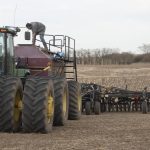Both the grain sector and government need to respond to rising fusarium rates, says the president of Alberta Seed Growers.
One of the first things to do is recognize that FHB has become a significant problem and then create policies that do not unnecessarily penalize producers, said Glenn Logan.
- Read more: Don’t delay if you haven’t lined up seed
“Across the province there’s a lot of variance in thought on this,” he said. “Some counties want to maintain the zero-tolerance level because they think they are fusarium free. If you look hard enough, though, you can find it pretty much anywhere.”
Read Also

Hail research hopes to benefit potato growers
Alberta research scientist measures hail storm and heat dome affects on potato crops
Sample testing by the Canadian Grain Commission shows a dramatic increase in Alberta in recent years. A decade ago, the percentage of positive results for fusarium were in the low single digits, and often zero or near zero. Now results in the high teens or above 20 per cent are commonplace.
More seed treatment is also needed, said Logan.
“A few years ago a study showed that you could safely treat seed up to about five per cent fusarium infection and kill it on the seed,” he said. “Treating seed won’t do much about soil infected by fusarium, but you can safely plant the seed on fusarium-free soil and maybe not have to worry so much.”















